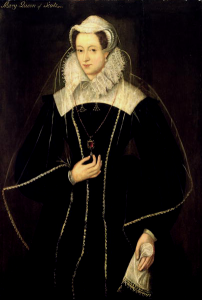In the early hours of Wednesday 8th February 1587, Mary Queen of Scots lay fully dressed on her bed in Fotheringhay Castle. Her women surrounded her, attired in black mourning garments, but sleep evaded Mary this night, as this would be her last on earth.
After eighteen years of imprisonment, her end was finally near and the sound of hammering from the great hall where the scaffold was being erected was a constant reminder of her fate – one that she had only been informed of the previous night.
At six o’clock in the morning, the queen rose, distributed her purses and farewelled her ladies. She then spent time alone in prayer but this welcomed solitude was interrupted at between eight and nine in the morning, when a messenger arrived informing Mary that the lords were waiting for her.
Mary requested time to finish her prayers but this panicked the lords who thought this could be a last minute attempt to resist their authority but when the sherrif of Northampton, Thomas Andrews, entered Mary’s room he found her indeed at prayer, kneeling before a crucifix hanging above her altar.
The queen was calm and demonstrated no fear, as she made her way to the great hall. Some contemporary observers even described her as ‘cheerful and smiling’ (Fraser, p.664). Mary was dressed almost entirely in black with a long white veil, edged in lace that flowed down her back and a red petticoat. She wore a ‘white stiffened and peaked head-dress that too was edged with lace, below which gleamed her auburn hair.’ (Fraser, p. 667)
Fraser describes Mary’s dress in detail,
‘Her satin dress was all in black, embroidered with black velvet, and set with black acorn buttons of jet trimmed with pearl; but through the slashed sleeves could be seen inner sleeves of purple, and although her shoes of Spanish leather were black, her stockings were clocked and edged with silver, her garters were of green silk, and her petticoat was of crimson velvet.’ (p. 667)
As they approached the great hall Mary was informed that her servants could no longer attend her, she was to die alone by orders of Queen Elizabeth.
According to Antonia Fraser, the queen pleaded with Sir Amyas Paulet and the lords to allow her servants to be with her at the time of her death,
‘so that they could later report the manner of her death in other countries. Kent replied that her wish could not well be granted, for before the execution her servants were sure to cry out and upset the queen herself, as well as disquieting the company, while afterwards they might easily attempt to dip their napkins in her blood for relics.’ (p. 666)
Mary assured the lords that this would not be the case and argued that in the past, gentlewomen had been allowed their servants to accompany them at their execution. After a short time, the lords conceded to Mary’s request and Melville, Bourgoing, Gervais and two of Mary’s women, Jane Kennedy and Elizabeth Curle accompanied their mistress to the scaffold.
Carrying a crucifix and a prayer book, the queen entered a silent great hall. The spectators watched as Mary made her way on to the wooden stage that was draped in black and about twelve feet square and two feel high off the ground (Fraser, p. 668).
On the stage there were two stools for Shrewsbury and Kent, the block also draped in black, and a little cushioned stool for the queen to sit on while she was being disrobed.
Then there was the axe.
Mary was led up the steps and waited patiently as the commission for her execution was read aloud. Dr Fletcher, the Protestant dean of Peterborough, ‘proposed to harangue the queen according to the rites of the Protestant religion’ but Mary responded by asking him to leave her as he would gain nothing from his actions.
The dean knelt on the steps of the scaffold and began to pray out loud, Mary paid him no attention and instead began her own prayers, firstly in Latin and then in English for all to hear. According to Fraser, Mary prayed for the afflicted Catholic Church, for her son and for Elizabeth.
As customary, the executioners asked the queen for forgiveness to which she responded, “I forgive you with all my heart, for now I hope you should make an end of all my troubles.”
Mary’s ladies removed her black dress and the queen was left standing in her crimson velvet petticoat, red sleeves and crimson-brown satin bodice. Fraser notes that the queen was ‘thus wearing all red, the colour of blood, and the liturgical colour of martyrdom in the Catholic Church’ (p. 669)
Sir Robert Wingfield of Upton witnessed Mary’s execution and recorded the events three days later. Once Mary’s eyes had been covered, her ladies left the stage
‘and she kneeling down upon the cushion most resolutely, and without any token or fear of death, she spake aloud this Psalm in Latin, In Te Domine confido, non confundar in eternam, etc. Then, groping for the block, she laid down her head, putting her chin over the block with both her hands, which, holding there still, had been cut off had they not been espied. Then lying upon the block most quietly, and stretching out her arms cried, In manus tuas, Domine, etc., three or four times. Then she, lying very still upon the block, one of the executioners holding her slightly with one of his hands, she endured two strokes of the other executioner with an axe, she making very small noise or none at all, and not stirring any part of her from the place where she lay: and so the executioner cut off her head, saving one little gristle, which being cut asunder, he lift up her head to the view of all the assembly and bade God save the Queen. Then, her dress of lawn [i.e. wig] from off her head, it appeared as grey as one of threescore and ten years old, polled very short, her face in a moment being so much altered from the form she had when she was alive, as few could remember her by her dead face. Her lips stirred up and a down a quarter of an hour after her head was cut off.’
Both Carol Schaefer and Antonia Fraser relate the story recorded in Wingfield’s account, that when the executioner held Mary’s head up for all to see he was unaware that Mary was wearing a wig and so her head is said to have fallen to the ground while her ‘hair’ remained firmly in his grip.
Another story of which Wingfield is also the source, again told by Mary’s biographers, is that when time came to strip Mary of her remaining adornments, the executioner discovered Mary’s dog hiding under her petticoat. The dog, covered in Mary’s blood, was taken away and washed but it is said that he never recovered from the loss of his mistress and soon perished.
Some believe these stories to be apocryphal.
When news of Mary’s execution reached Elizabeth, she reacted indignantly claiming that her secretary Davidson had used the warrant without her express permission. Davidson was arrested and taken to the Tower but was later released after paying a hefty fine.
Mary was eventually buried at Peterborough Cathedral but later moved by her son, James I of England, who in 1612 had her exhumed and reinterred at Westminster Abbey only a few feet away from her cousin, Elizabeth.
As summed up by Alison Plowden,
‘All the bitterness and tragedy, all the passions roused by their deadly rivalry, transmuted by time into dust and marble.’
Image Source
References
Fraser, A. Mary Queen of Scots, 1969.Schaefer, C. Mary Queen of Scots, 2002.
THE EXECUTION OF MARY QUEEN OF SCOTS?FEBRUARY 8, 1587, viewed February 8 2012, http://tudorhistory.org/primary/exmary.html
Mary Queen of Scots, viewed February 8 2012, http://www.findagrave.com/cgi-bin/fg.cgi?page=gr&GRid=4171























At the end of my beginning. This motto has
chosen Mary Stuart. She was right. For the life
hereafter, after his death many have written
a bout it, even Juliusz S?owacki.
Great article….such a horrible ending she had, after such a long imprisonment…very sad that it had to happen the way it did.
This Queen raises such passion in people, whether they are for or against her, and she always will I think. I hope she has found the peace that evaded her in life.
Such an awesomely writte post. I mentioned this in History the other day as we’re looking at Elizabeth and the various “threats” against her reign, including Mary. Such an interesting and poignant time in history!
I can’t believe that Mary ended up burning so many people as heretics. It seems as if she was brainwashed. I am glad that both Mary and Elizabeth got to sit on the throne as queen of England because it was their right.
oops, Laura I think you have the wrong Mary here… hope you don’t mind me saying 🙂
Mary was rightful heir, being daughter of Katherine and Henry as was Elizabeth being daughter of Anne and Henry. Mary would gladly have got rid of Elizabeth and in fact did put her in the tower at one point. Mary wanted to make England a catholic monarchy secured by marriage to Philip of Spain who really wanted the English crown
Different Mary -this was mary Stuar – Scots Queen -not Mary Tudor Elizabeth’s half sister
Yes a fantastic post , been doing my homework and it’s come in very useful. Yep Laura, your on Mary Tudor, also know as Bloody Mary , who killed thousands of Protestants. Mary Stuart however is the woman in this post, thought to have made plots again Elizabeth 1.
Poor woman, though you can’t deny she was definitely unfit for reigning. But she had such a bad, yet interesting life. It’s hard to believe that once you’ve got a figure like her, people like the writers on that horrendous CW series make things up. I even wrote a piece on how inaccurate that is: http://prettyandwittyandbright.wordpress.com/2014/10/03/on-tv-revisting-reigns-first-season-and-the-horrors-of-historical-fanfiction-ahem/
Please, check it out!
Long live the Queen….of Scots!
Mary Stuart was a passionate woman misguided on occasion but to me a true heroine.